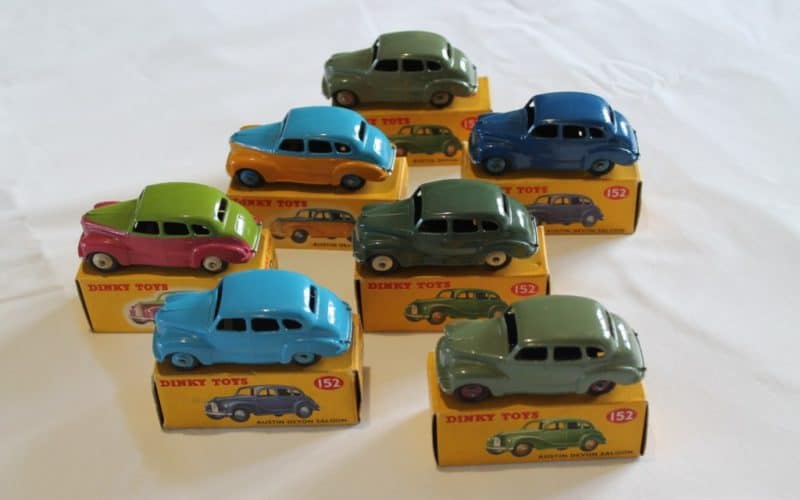
History
First released in a trade box of six models in 1949, this model with seven others became affectionately known as one of the 40 series by Dinky enthusiasts. I believe it was the third release following the Riley 40a and Triumph 1800 40B, but for some reason the renumbering which took place in 1953-54 did not follow the same order, for example the Riley became ‘158’ and the Austin Devon ‘152’.
The model itself changed very little over its manufacture which ended in 1959. The following observations identify changes that I have recognised.


Casting & Base Plate
There were three changes to the casting and base plate during the models release. The early models had small writing on the base plate and no printing on the underside of the roof.
The second phase changed the base plate to large writing and retained no printing under the roof. The final phase retained the large writing base but had ‘Devon’ printed on the underside. This is helpful for the enthusiast as you are able to date the models more accurately and those which are likely to have had a dual number box.
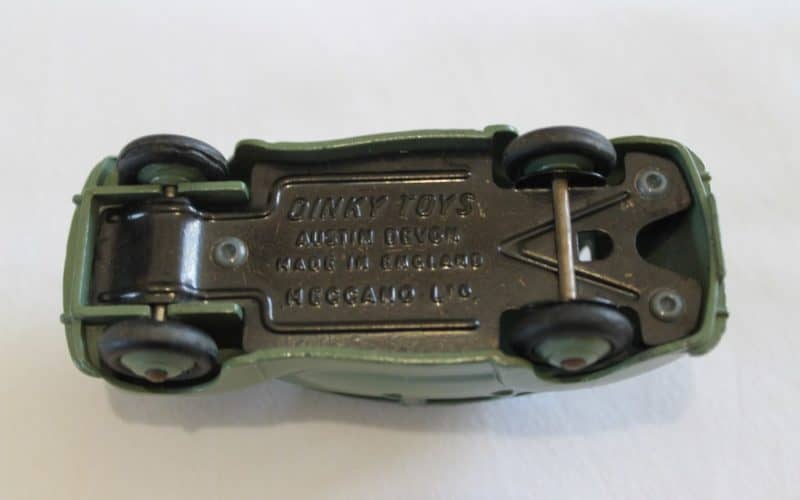
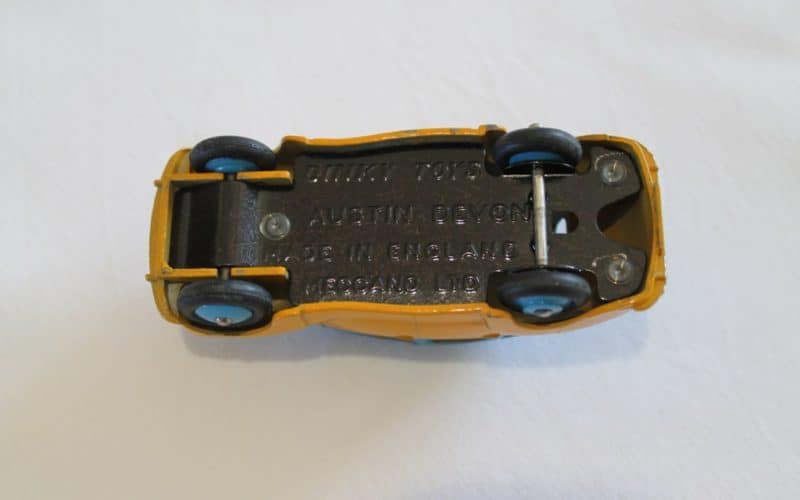
Tyres
The tyres were the smooth black type through out its manufacture.
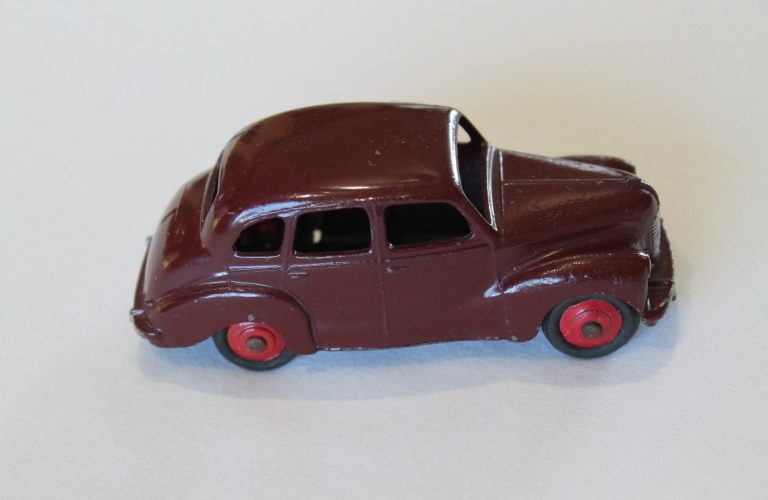
Box Packing - Trade Boxes
The packing of these models was provided in trade boxes of six to the shop keeper and these came in several designs. A Type 2 trade box (not often seen) was the first release post war and this was a brown box with yellow label to the end, with model description marked ‘40D’.
A Type 3 box was then used, this was an all yellow or all cream box with model description, as Type 2 directly printed, there was no label. This was followed by a Type 4 box similar to a Type 3, but with a 5 digit reference code. The final box was a Type 5 which was all over yellow as before but now offering the dual numbering and for the first time identifying ‘152’ its eventual final coding.

Individual Box
There were just three designs used. They were similar in being the yellow box with red ‘Dinky Toys’ on the ends and sides.
Type 1
This was a dual numbered box with black end ovals and white numbering 152, with red early numbers ‘40D’ to each side of the oval. There was no numbering on the picture sides. Colour stickers were often applied to denote the colour within. The models printed either side were blue or maroon.
Type 2
This type now dropped the dual numbering but included a printed colour spot at each end to identify the model within and had large red ovals with white writing on the model picture sides.
Type 3
The final box change was similar to Type 2, except the model colour pictures denoted the two late two tone colours released. What garish colours they were too. You would never have seen these colours on the real full size car, but they have been massively popular for the collector.
Models
Type 1 models seen with small writing base plates and smooth roof undersides. These models are likely to have originated from a trade box, though it is possible any could have been sold through the early dual number box. The following models date from 1949-54:
- Maroon body and wheels
- Maroon body and red wheels
- Red body and maroon wheels
- Light grey-green body and wheels
- Dark Blue body and blue wheels
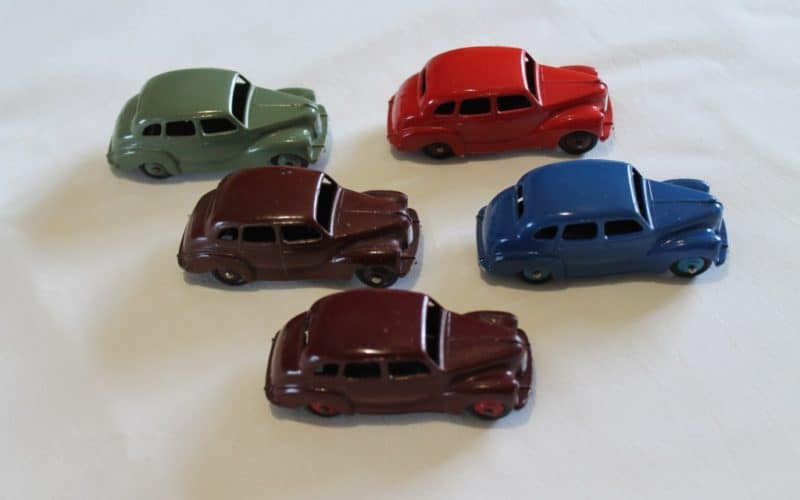
Type 2 models seen with large writing base and smooth roof underside; issued between 1953-56 approximately.
- Dark blue body and blue wheels
- Tan body with green wheels
- Light grey-green body with tan wheels
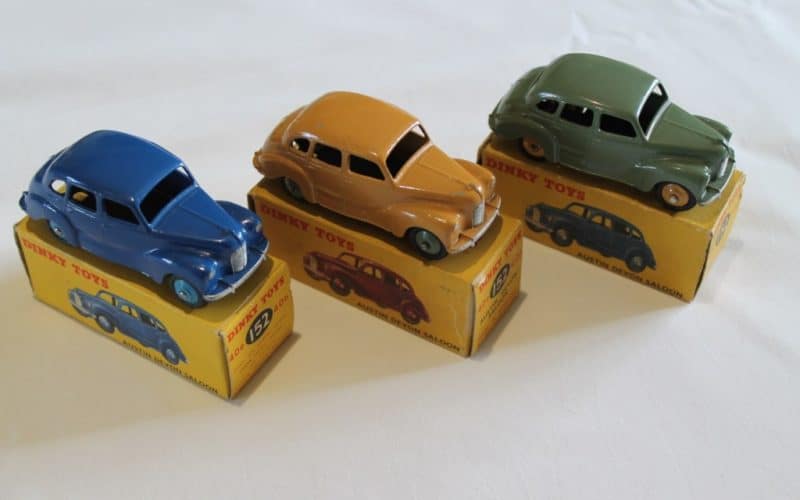
Type 3 models with large writing base and ‘Devon’ printed on the underside of the roof; issued 1956-59.
- Dark Blue body and blue wheels
- Light grey-green body and maroon wheels
- Lighter green body and fawn wheels
- Darker green body and fawn wheels
- Darker green body and cream wheels
- Blue body and wheels
- Blue and yellow body with blue wheels
- Cerise and lime green body and cream wheels

Sales & Evaluation
Never an easy task when you have for example the darker blue body with all three types. Therefore I have collated the sales as one. Various shades exist. I have tried to provide a guide only and a fair reflection of sales and how easy each model is to obtain.
The sales’ totals reflect the total sales of each colour not whether they were sold un-boxed as a ‘40D’ or boxed item as a ‘152’, and in a wide range of condition from mint to play worn.
I have utilised two additional main stream sales businesses, as well as my own Diecast Gems sales and stocks to reflect the units sold, these sales are archives of the last 15-20 years.
For the collector this model has always demanded high premiums when found in mint condition with a very nice box. There are many rare variations to find and these may fetch whatever price the buyer and seller can agree on.
Previous Sales
The total sales recorded for this survey since August 2000 are 277 models. The distribution is as follows.
- 42 Maroon body and wheels
- 1 Maroon body and red wheels
- 12 Red body and maroon wheels
- 44 Light grey-green body and wheels
- 4 Light grey-green body and maroon wheels
- 21 Lighter green body and fawn wheels
- 19 Darker green body and fawn wheels
- 12 Darker green body and cream wheels
- 48 Dark blue body and blue wheels
- 12 Tan body with green wheels
- 1 Light grey-green body with tan wheels (an exact reverse of the above)
- 17 Mid Blue body & Wheels
- 34 Blue and yellow body with blue wheels
- 27 Cerise and lime green body and cream wheels



Model Values
- I have a maroon example which looks almost brown seen in the picture below.

- The lighter green-grey with tan wheels is the only example I have ever seen.
- Maroon with red wheels only example I have seen.
- Note the blue model had the longest run and can be found in all three casting and base configurations.
- Missing from the final photo is the darker green with fawn wheels and usually coloured all maroon.
If you are aware of any genuine variations not listed above, please feel free to email me with details and pictures and I will always consider adding to the above article or follow with a blog.
Below is a guide to value, in my own opinion.
1st Early issues with small writing, unboxed.
- Maroon body and wheels – £125-£175
- Maroon body and red wheels. Very Rare – £600-£950
- Red body and maroon wheels. Rare – £600-£950
- Light grey-green body and wheels – £100-£150
- Dark blue body and blue wheels – £130-£175
Note; If mint dual number boxed examples add £100
2nd issues with large writing and smooth inside roof, boxed.
- Dark blue body and blue wheels – £230-£275
- Tan body with green wheels. Rare – £750-£950
- Light grey-green body with mustard wheels. VV Rare – £900-£1250
3rd issues with large writing and the model name cast in roof underside boxed.
- Light grey-green body & maroon wheels. V Rare – £750-£1000
- Lighter green body and fawn wheels – £200-£300
- Darker green body and fawn wheels. Scarce – £250-£325
- Darker green body and cream wheels. Scarce – £275-£350
- Dark blue body and blue wheels – £230-£275
- Blue body with blue wheels. Rare – £700-£1000
- Blue and yellow body with blue wheels – £450-£600
- Cerise and lime green body and cream wheels – £450-£650
Note.
Price guide is for mint models and boxes only.
Of the rare models there were very few examples mint or near and most sold were play worn to some degree.
The rare items may fetch even higher prices than those indicated and examples are recorded considerably higher when you take an auctioneers commission into account.
The majority of sales fall far below the values provided when condition is only average.
I hope you enjoy this article and any comments you may have will be gratefully received.